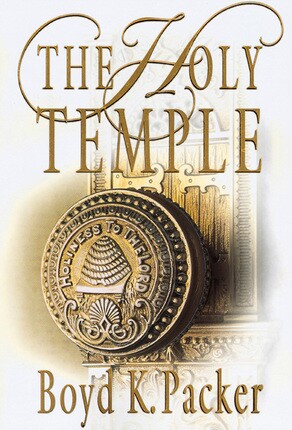The following excerpt from The Holy Temple by President Boyd K. Packer illustrates how we can receive "help from beyond" to do temple work.
At the rededication of the Logan Temple in 1979 I recounted an incident in the life of my wife's grandfather, which I include here.
The Logan Temple is sacred to our family, for there my wife and I were married, and my wife's grandfather responded to the call and helped to construct that temple.
C. O. Law, the superintendent of construction for that temple, wrote on February 25, 1884: "This letter certifies that Brother Julius Smith of Brigham City has worked faithfully and honorably on the Logan Temple for nearly two years, and as the temple nears completion, his branch of the labor being terminated, he is now honorably released and we sincerely trust that Brother Smith may become a participant in the blessings of the House of the Lord which he has assisted to erect."
Brother Smith with his wife, Josephina, lived on a few acres of ground in Brigham City. There they raised fourteen children, my wife's father being the youngest. When the call came for workers to assist in the building of the temple, he responded.
Each Monday morning he left his family in the care of his wife and hiked up through Flat Bottom Canyon, down Dry Canyon to the south end of Cache Valley, and on to Logan. After his week's work on Saturday, he walked home to spend Sunday with his family.
He was not a young man, just over five feet tall, and very slight in build. He was, nevertheless, assigned as a hod carrier. For the younger readers I explain that a hod carrier would fill a V-shaped wooden box full of mortar or plaster. He would lift it to his shoulder and carry it to where the masons were working, often carrying this very heavy weight up long ladders.
On the afternoon of August 11, 1883, Brother Smith was supplying two plasterers who were finishing the ceiling a hundred feet above the ground in the northwest tower of the temple. Suddenly the scaffolding gave way, tipped to one side, and fell. The projections for the spiral staircase had been installed. The three men tumbled through these projections and landed at various levels amid the rubble. The record states that they were removed to their homes and soon returned to their work, having sustained only minor injuries.
The hope "that Brother Smith would participate in the blessings of the House of the Lord which he had assisted to erect" was amply fulfilled. He went there often.
As a young man he had lived among the Indians. In later years when Indian bands would visit Brigham City, one of the Indians would go to the home of Brother Smith. His visits were not welcomed by the rest of the family, for he would peer in every window intently until he determined that Brother Smith was home. And only then would he knock at the door.
One night, some years after the completion of the temple, Brother Smith was reading his newspaper. He heard a noise at the window, and he saw his Indian friend peering in with an unusually sad expression. He went to the door and found no one there, and the snow beneath the window had not been disturbed.
This incident bothered him greatly, and during the following week he tried to locate and get some information about this Indian friend. He learned that he had died.
In due time, he recorded, "Today I have taken care of his work in the temple." That very evening he was looking through the mail and again heard a sound at the window. When he looked up he saw his Indian friend, this time smiling. He counted that a very sacred experience, and in the record of a great amount of work done by this faithful grandfather in this temple is found the name Be-a-go-tia.
I have wondered over the years about the meaning of the scripture recorded three times in the Book of Mormon, that "the course of the Lord is one eternal round." (1 Nephi 10:19, Alma 7:20, Alma 37:12.)
I can see one meaning as it relates to our work for the dead. Genealogical work, the essential preparation for temple work, puts us to seeking through the records for those who have lived in the past. We look back to the past to find them. We perform temple ordinance work for them and then we look forward to the future to meet them. Something sacred is consummated when we have safely recorded, in the list of ordinances completed, the names of those who lived in our past and who yet live in our future. This ordinance work is crucial to us and to the Church.
Read this groundbreaking book—one of the most comprehensive and definitive works written about temples.
In President Packer’s characteristic warmth and authoritative manner, he examines in appropriate detail the doctrines and practices surrounding the holy temples that dot the world. A timely and valuable book, The Holy Temple will help members at every stage of life as it focuses on a temple’s purpose, beauty, and the blessings it offers.
Part one offers the Lord’s invitation: “Come to the temple.” It sets forth the requirements for attendance and the attitude and behavior appropriate for those attending that holy place on the first and all subsequent occasions. Part two deals in brief fashion with the ancient temples, then turns to the central human figure in the work of the temple—Elijah the Prophet, who anciently held the keys relative to the sealing power of the priesthood. Malachi’s prophecy and the human tradition about Elijah’s return in the latter days are impressively set forth.
Elijah’s return and all that it means for the happiness and salvation of man-kind are the themes of parts three and four. Following early Restoration scenes, the Kirtland Temple is built at great personal sacrifice. Dedicated, it fulfills a major purpose in the glorious visions of April 3, 1836, the Savior himself introducing three heavenly beings who then convey priesthood keys. One of these is Elijah. Thereafter the revelations progressively develop the doctrine of temple work for both the living and the dead; under divine direction temple ceremonies are introduced, and participants eagerly flock to the Nauvoo Temple; through President Wilford Woodruff the supporting work of lineage linking is clarified by revelation; and the spirit of Elijah is manifest both in and out of the Church as genealogical research and temple work blossom, temples multiply, and those beyond the veil assist those involved in the work here.


